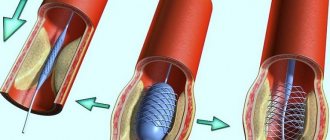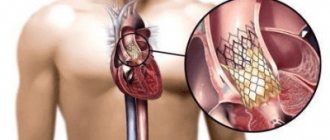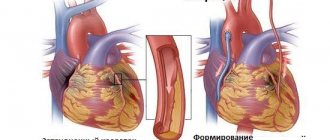A heart attack imposes certain lifestyle restrictions on the person who has suffered the attack. After treatment, the patient cannot perform physical activity and needs a calm environment and a positive emotional background. In many cases, a special rehabilitation regime and release from work are required. For such situations, it is possible to create a disability group after a heart attack and stenting.
In addition to official exemption from work, special status gives the right to financial support from the state. The pension amount is assigned depending on the severity of the condition. We'll look at this in more detail later.
Do they give special status after a heart attack?
You can get disability after myocardial infarction and stenting if there are complications of the disease. To confirm them, you need to undergo an examination and submit an application to an expert commission, which makes the appropriate decision.
In theory, obtaining status is not difficult, but you need to be prepared to visit doctors and get tested. It can be difficult to do this on your own due to a heart attack. It’s good if there is a friend or relative nearby who is ready to help. It is better to make an appointment in advance to avoid tiring waiting in lines.
To avoid wasting time on paperwork, first consult with your doctor. Let a specialist assess your current condition and prospects for rehabilitation. Be also prepared for the fact that members of the expert commission may require additional examination and include narrow specialists in the list.
New rules in 2021
Government Decree No. 92 of 02/01/2021 extended the temporary procedure for recognizing a person as disabled until the end of 2021.
At the same time, changes were made to the rules for conducting a medical and social examination (MSE) in absentia and the rules for recognizing a person as disabled in 2021 without being called to a commission. ConsultantPlus experts discussed how to apply for disability. Use these instructions for free.
to read.
What group can you get?
The commission makes a decision on whether disability is due after a heart attack and stenting based on a comprehensive examination of the patient. Depending on the degree of heart damage and consequences, the first, second or third group can be assigned. Each provides its own privileges in terms of work and preferential financing.
First disability group
The ability to independently serve one’s needs has been lost by 80-95%. People with such a percentage of heart attack lesions are considered disabled.
For this form of the disease, the following benefits are prescribed:
- social pension;
- free travel on buses, trams and trains;
- free medicines;
- spa treatment once a year;
- working week no more than 35 hours;
- exemption from payment of transport tax and real estate tax;
- 50% discount when paying for housing and communal services (if there is more than one apartment, then to choose from).
Second disability group
The second degree is assigned to moderate heart attacks. Such people can perform their labor function only if favorable conditions are created, both physical and psycho-emotional.
Almost all the same preferences apply here as for people with group I. The only exception is in terms of providing medications: for some medications you will have to pay 50% of the cost.
Third disability group
Group III disabled people are entitled to:
- 50% discount on the purchase of medicines;
- 50% discount on utility bills;
- social pension;
- free travel on public transport;
- up to 60 days of vacation at your own expense.
Depending on the degree of complications, you can count on a free nurse. But if relatives live in the house with the patient, they will first have to prove that they themselves cannot perform the functions of care. To do this, the social security authority will need to provide proof of employment confirming full-time employment.
Receipt procedure
The maximum period of sick leave for a heart attack is 4 months. If after this period the patient has not improved, he or his relatives can apply for an ITU.
The basis for examination, regardless of the patient’s condition, is also the performance of work in positions that are contraindicated in case of a heart attack. These include work in construction, aviation, security, courier service, etc. A detailed list can be found in the regional social security office.
To obtain disability after a heart attack and stenting, you need to submit a corresponding application to the expert commission. The following documents are attached along with the application:
- passport;
- a referral to ITU from the applicant (you can fill it out yourself or ask one of your relatives);
- referral from the attending physician;
- SNILS;
- medical history or medical record, which reflects the patient’s condition;
- open sick leave (if available);
- a copy of the work book;
- conclusion from the place of work on the nature of the activity performed.
You can submit documents in person or by mail. The commission reviews the package within 30 days, after which it sends an invitation for inspection. The examination takes place at the patient’s place of residence. If the applicant cannot appear for the commission on his own, then she comes to his home.
The assignment of special status takes place according to the principle of voting. The results of the discussion are recorded in the minutes, on the basis of which a decision is made. The corresponding regime is assigned by the act.
Medical and social examination
Coronary artery bypass grafting
CABG is a surgical intervention to perform operations on the vessels of the heart in order to restore blood flow in the coronary bed.
One of the main indications for surgery is coronary heart disease. Additional indications for performing CABG on a patient:
- persistent manifestations of angina pectoris that cannot be corrected by drug treatment,
- significant narrowing of the coronary bed,
- high risk of myocardial infarction.
In the classic version, coronary artery bypass surgery is a rather complex and dangerous surgical intervention for the patient, consisting of the following main stages:
- To begin with, the patient is subjected to general anesthesia.
- Next, the chest is opened using a median sternotomy.
- The pericardial cavity is opened, and in parallel with the process, a vessel is taken, which will later be used as a shunt.
- After a series of measures, the heart is connected to a heart-lung machine.
- Next, a shunt is applied and the heart is removed from the artificial blood supply and, under the conditions of a contracting organ, the aorta and interventricular artery are connected by a shunt.
- The blood supply to the myocardium is restored, the chest is sutured.
Read also: Disability due to hypertension: features, groups
Disability after cardiac bypass surgery
Having undergone heart bypass surgery is not necessarily a reason for disability. CABG allows the heart to restore function and the patient to return to their normal lifestyle.
If after the operation the heart function is restored, ultrasound reveals no abnormalities or they are insignificant, and the patient’s condition is good, the person is not considered disabled. However, bypass surgery is a reason to prescribe a medical rehabilitation commission (MREC), which includes an examination by expert doctors headed by the chairman.
The commission analyzes the medical history, examination results, and the patient’s condition and makes a decision on the presence or absence of symptoms indicating disability. If there are pronounced disturbances in the functioning of the cardiovascular system, difficulties in carrying out work activities and performing the necessary actions for self-care, a person is assigned a disability group. In case of persistent and irreversible changes in the functioning of the heart and the age of the patient (in women over 55 years old, in men over 60 years old), a lifelong group may be assigned. But this happens quite rarely.
For how long is disability granted?
A heart attack is recognized as a disease in which recovery is possible. Depending on the severity of the disease, status may be issued for one or two years. In severe cases, the status is assigned for 2 years, but in the second and third cases you will have to undergo a new examination a year after the first commission. Exceptions are possible, but they are rare.
If doctors consider that over the past period the patient feels noticeably better and can perform work functions (fully or in a limited mode), then the list of work restrictions, and with them the benefits, may be changed or canceled altogether. This decision is made based on the results of the re-examination.
They can also be allowed to work if the work does not involve serious emotional or physical stress. If the commission considers the likelihood of recovery low, then such patients may be assigned status indefinitely.
What benefits can you expect in case of refusal?
If the commission considers that the patient has fully recovered, does not require outside assistance in performing daily functions and can carry out work activities, then the status will be denied. They may not give a group even if the commission considers the current working conditions favorable. If necessary, sick leave can be extended for up to 120 days. Sometimes it is only possible to shorten the working week or indicate a change in workplace.
Without recognition of disability, the patient cannot enjoy full financial benefits. But since 2021, all people who have had a heart attack have the right to free medicines. They are issued immediately after discharge from the hospital and are subsequently provided for a year after myocardial infarction. This measure is intended to support all patients who find themselves in difficult situations and reduce the financial burden on their families. Detailed information can be found in Order of the Ministry of Health No. 1n dated January 9, 2021.
There should be no problems with the necessary medications; the authorities allowed us to receive medications six months in advance. In total, the list of free medicines contains 23 names of drugs of domestic and foreign production. They promise to expand this list until 2023.
A document to receive medications can be obtained from your attending physician. To do this, you need to bring your compulsory medical insurance policy, SNILS, passport and extract from the hospital to your appointment. With the finished prescription, you can go to the pharmacy.
Re-examination procedure
Re-examination for a disability group is a voluntary exercise and can be prescribed by mutual decision of the patient and the attending physician. The referral reflects the treatment procedures prescribed during the rehabilitation period and makes a conclusion about their effectiveness (they helped, helped slightly or did not help).
The rest of the list of documents is the same as for the initial application. It should also be accompanied by a certificate of the current disability group and an individual rehabilitation program developed by the previous commission. The rehabilitation card must indicate that you have completed all stages of treatment, otherwise you will definitely not be given a new group.
If the rehabilitation program specifies requirements for the work regime, you will need to contact the employer for a mark of completion and a signature on compliance with the prescribed conditions.
Assignment of disability after stenting
The procedure of stenting, or revascularization, is designed to improve the patient’s condition and facilitate recovery after an attack. Based on the results of the procedure, the doctor evaluates its effectiveness and records the result in writing. The subsequent decision of the commission depends on how useful stenting turned out to be:
- Great effect. Good tolerance to physical activity, no or only slight angina.
- Good effect. Angina pectoris is moderate and practically does not bother me. Light physical activity is possible.
- Satisfactorily. Angina pectoris only appears after intense exercise.
- Unsatisfactory. This assessment indicates that the patient's condition has not changed.
When stenting, the principle of submitting documents and undergoing examination is the same. You can find out whether patients are given disability after stenting of cardiac vessels from their attending physician. Typically, a group is assigned if the results of the procedure are insufficient to continue a full life, but for this you will have to undergo a new examination.
Complications arising from heart bypass surgery
Almost every surgical procedure carries a risk of complications for the patient, especially heart surgery.
Despite the positive dynamics of coronary artery bypass grafting (CABG), patients may experience the following complications:
- bleeding in the area of the surgical wound,
- bleeding and infection of the wound at the site of the vein incision (usually the thigh area),
- dysfunction of the shunt due to its narrowing,
- opening of seams,
- pain and heat in the chest area,
- deterioration of cognitive processes,
- thrombosis of venous beds,
- the occurrence of angina attacks,
- disruption of blood supply to the brain,
- general weakness of the body.
Important! To eliminate the possibility of complications, you must adhere to strict rules for the postoperative recovery period given by your doctor.











